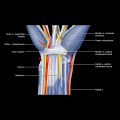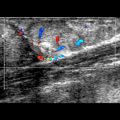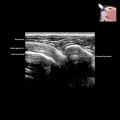Paraarticular Cystic Mass
ESSENTIAL INFORMATION
Key Differential Diagnosis Issues
Helpful Clues for Common Diagnoses
 Mucinous fluid contained within fibrous pseudocapsule
Mucinous fluid contained within fibrous pseudocapsule
 Results from extruded synovial fluid
Results from extruded synovial fluid
 Most common around wrist/hand and foot
Most common around wrist/hand and foot
 Typical locations reflect weakness in joint capsule
Typical locations reflect weakness in joint capsule
 Near A1 pulley on middle, index, and ring fingers
Near A1 pulley on middle, index, and ring fingers
 Anechoic, well-defined, rounded or irregular mass alongside joint
Anechoic, well-defined, rounded or irregular mass alongside joint
 Typically has neck pointing toward particular joint
Typically has neck pointing toward particular joint
 Most ganglia per se are not painful with pain induced by ganglion leakage
Most ganglia per se are not painful with pain induced by ganglion leakage
 50% of ganglia recur after percutaneous aspiration
50% of ganglia recur after percutaneous aspiration
 Semimembranous-gastrocnemius bursa, which communicates with joint
Semimembranous-gastrocnemius bursa, which communicates with joint
 Classic talk-bubble configuration on transverse US with beak of bubble emerging between semimembranous tendon and medial head gastrocnemius muscle
Classic talk-bubble configuration on transverse US with beak of bubble emerging between semimembranous tendon and medial head gastrocnemius muscle
 Usually extends distally over medial belly gastrocnemius muscle
Usually extends distally over medial belly gastrocnemius muscle
 Has synovial membrane and therefore affected by synovial processes (e.g., PVNS) involving knee joint
Has synovial membrane and therefore affected by synovial processes (e.g., PVNS) involving knee joint
 Prone to either hemorrhage or leakage
Prone to either hemorrhage or leakage
 Hemorrhage
Hemorrhage
 Leakage or rupture
Leakage or rupture
 2 types of bursae
2 types of bursae
 Synovial bursae: Synovial-lined bursa, which occur at defined anatomical locations
Synovial bursae: Synovial-lined bursa, which occur at defined anatomical locations
 Adventitial bursae: Non-synovial-lined bursae acquired due to friction between opposing structures
Adventitial bursae: Non-synovial-lined bursae acquired due to friction between opposing structures
 Some paraarticular bursa more prone to bursitis than others
Some paraarticular bursa more prone to bursitis than others
 Subacromial-subdeltoid bursa
Subacromial-subdeltoid bursa
 Olecranon bursa
Olecranon bursa
 Iliopsoas bursa
Iliopsoas bursa
![]()
Stay updated, free articles. Join our Telegram channel

Full access? Get Clinical Tree















